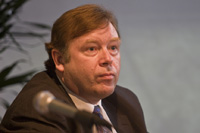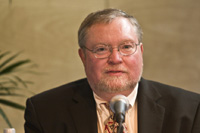Burkenroad Symposium explores emerging technologies
From rooftop solar panels to tissue-engineered human organs, many of the innovations we take for granted today became reality through the combined efforts of scientists, inventors, entrepreneurs and venture capitalists.
For the 17th Burkenroad Symposium on Business and Society, "The Quest for Fool's Gold: The Risks and Rewards of Emerging Technologies," three nationally respected experts in the areas of nanotechnology, alternative energy and regenerative medicine offered their thoughts on what it takes to bring cutting-edge technologies to market.
The symposium, an annual presentation of the Burkenroad Institute, took place on Friday, Feb. 26, in the Lavin-Bernick Center. Laura B. Cardinal, Exxon Professor of Strategy and director of the institute, moderated the event.



David L. Carroll, director of the Center for Nanotechnology and Molecular Materials at Wake Forest University, has spun off a number of successful companies from technologies developed at the center.
Carroll said the challenge to spinning off a company often has more to do with management than the technology itself.
"Typically speaking, the technology you're trying to spin off does work-it's been vetted, it's been published, it's been patented," Carroll said. "[The challenge is] getting the management team together and realizing that what you're trying to do is to develop a product and aim it squarely at a marketplace."
Stephen R. Connors, director of the Analysis Group for Regional Energy Alternatives at Massachusetts Institute of Technology, emphasized the importance of focusing on market dynamics rather than the technology in isolation.
"Snake oil is not a biofuel," he quipped. "The basic chemical process may be right, but that doesn't mean it's a business let alone an industry. As you evaluate some pitch for a novel energy technology that's going to give you some competitive edge, what's the market niche?"
Closing out the symposium was Thomas B. Clarkson, director of planning and business development at Wake Forest's Institute of Regenerative Medicine, who discussed the institute's unique approach to commercializing technologies.
Clarkson said Wake Forest's Regenerative Medicine Technology Generator has two organizations that work cooperatively to commercialize regenerative medicine technologies. An internal organization focuses on clinical trials while an external organization focuses on management, business issues and funding.
"When you move programs through the different steps of clinical trials by having two cooperating organizations, you can be more efficient at bringing technologies to market," he said. "Our goal through this effort is to try to change the classical venture capital and university commercialization models."
Clarkson added that he expects so-called venture philanthropists, such as the Michael J. Fox Foundation for Parkinson's Research, to play an increasing role in developing technologies that serve patient populations too small to attract traditional venture capital funding.
Interested in advancing your education and/or career? Learn more about Freeman’s wide range of graduate and undergraduate programs. Find the right program for you.
Recommended Reading
- Matthew Higgins: The Strategy of Innovation
- Pierre Conner: The Future of Energy Is Now
- Meet the MBA Class of ’26: Joshua Christian
- What Can You Do With a Business Analytics Degree?
- Carol Lavin Bernick to deliver 2025 R.W. Freeman Distinguished Lecture
- Diego Bufquin
- Ukrainian scholar to discuss economic impacts of war
- Ernst & Young CEO highlights importance of global ethics
Other Related Articles
- Forbes: Your Pitch Deck Doesn’t Close the Deal - Your Power in the Room Does
- Research Notes: Alissa Bilfield
- Quartz: Companies that replace workers with AI ‘risk mediocrity,’ expert warns
- BBC News: ChatGPT will soon allow erotica for verified adults, says OpenAI boss
- Business Insider: Why a professor of finance isn't impressed by gold's stunning rally in 2025
- CNET: I Asked AI Chatbots About Problem Gambling. Then They Gave Me Betting Advice
- OHSonline: From the Battlefield to the Workplace - How Staff Rides Improve Safety Decision Making
- Three honored with Freeman teaching awards
